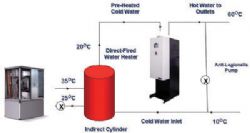Heat pumps are well known for their effectiveness when used with low grade space heating applications. However, air source heat pumps also present great potential as a low carbon solution in assisting the production of hot water in commercial buildings. Jonathan Tedstone, LZC product manager for Andrews Water Heaters and Potterton Commercial, looks at the opportunities and benefits.

Jonathan Tedstone
Heat pump technology is becoming increasingly relevant as a result of the drive for carbon emission reductions. The Eco-Design of Energy using Products (EUP) directive comes into force in 2011 and LA planning consent requires that 10 per cent to 15 per cent of the property's energy needs are satisfied with a renewable solution. Energy Performance Certificates, Display Energy Certificates and the CRC Energy Efficiency Scheme, which are now mandatory for qualifying organisations, all encourage the uptake of Low to Zero Carbon (LZC) solutions in commercial refurbishment projects.
One of the more immediate ways to do this is to design integrated system solutions incorporating the best available high efficiency conventional heating equipment with the most appropriately matched LZC technologies. Heat pumps are certainly a viable option within such a system and need not be restricted to providing low grade space heating.
Within new commercial buildings, which have to conform to high standards of insulation and air tightness, space heating loads are reducing and hot water is fast becoming the dominant thermal load. So it is logical that the focus for the application of LZC technologies, including heat pumps, should support the generation of hot water.

Andrews Ambiflo air source heat pump
Which low or zero carbon solution is applied will depend on its compatibility with the equipment being used, as well as considerations such as space, building orientation and external planning. A solar thermal installation may not be acceptable for listed buildings or there may be insufficient roof space for solar arrays. Ground source heat pumps require additional land for the ground loop or sufficient depth for a bore hole. CHP needs extended available running hours based on the thermal load in achieving its greatest potential.
Air source heat pumps can provide a low carbon pre-heat solution operating well with a variety of HE water heating systems and there are virtually no planning or space issues as air source heat pumps can be positioned anywhere outdoors in the most unobtrusive place. Air source heat pumps are perceived as a quick installation as it tends to be an out-of-the-box solution. They use the available energy within the ambient air to initiate and sustain a refrigeration cycle within the appliance. The refrigerant used (R407C in the case of the Andrews Ambiflo unit) evaporates at relatively low temperatures allowing operation even during periods of low ambient air temperatures. Once installed, the focus is to maintaining the CoP of the heat pump.

The schematic shows the air source heat pump load side temperatures are controlled to 35°C flow and 25°C return. Even at air temperatures of 2°C, a CoP of around 3.2 and an expected temperature within the pre-heat cylinder of say 20°C can be achieved. This reduces the amount of fuel required in the primary heating appliance to raise the water to 60°C typical set point of the water heater.
Higher temperatures within the cylinder can be achieved during periods of higher ambient air temperature as the heat pump water outlet temperature can be allowed to rise while sustaining a respectable CoP. However, the heat pump installation cannot be used for the entire hot water needs of the building as the only way of doing so would be by increasing the water flow temperature to a point which would adversely affect the CoP in a serious way, having a significant negative effect on the economic and environmental benefits offered by the technology.
Baxi Commercial
0845 070 1055
8 April 2010